Growing nephrolepis
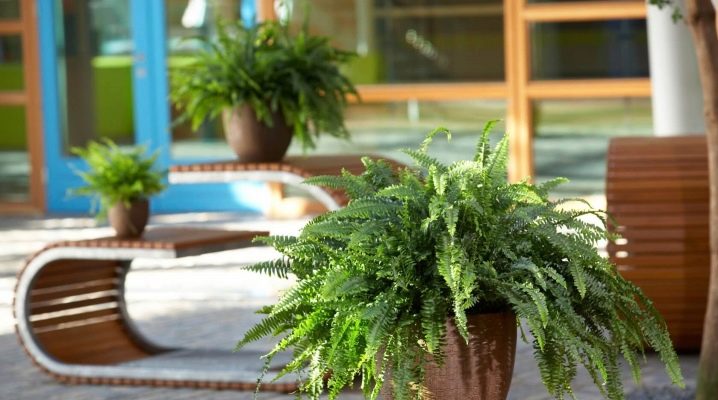
For a very long time, many flower growers have been successfully cultivating nephrolepis. This truly luxurious fern is known for its splendor, delicacy and, most importantly, unpretentiousness. This plant, when cultivated at home, does not require any specific care. Another important feature is that the flower can be kept at home, and in the warmer months it can be moved outside (to the garden, to the terrace or to the balcony). This plant looks harmoniously in hanging pots (pots) when decorating an interior, but its value lies in both decorative qualities and useful properties.
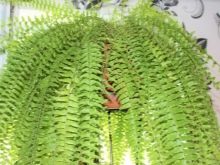
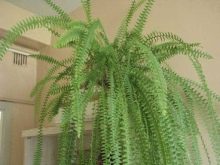
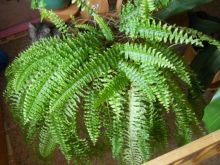
Views
Analyzing the variety of species of this plant, it should be borne in mind that today there are certain disagreements in botanical catalogs regarding the belonging of nephrolepis. According to one of the versions, he is a representative of the Davallievs. According to her opponents, this gorgeous fern belongs to Lomariopsis. In any case, we are talking about a herbaceous perennial, capable of feeding in two ways: as a terrestrial representative of the flora or as an epiphyte. The second option provides for the development of plant-based nephrolepis without using it as a donor.

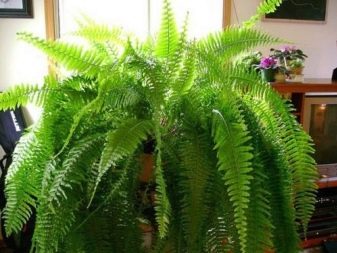
All varieties and varieties are distinguished by tenacious, with rather short elements of the root system. Leaf rosettes are formed by short-peaked dissected leaf plates, reaching a length of 0.7 m. A characteristic feature of nephrolepis is the serrated edge of the leaf segments. Another important point is the presence of shoots in the form of scaly whiskers. They are one of the vegetative reproductive organs of the fern. Upon reaching the ground, these whiskers quickly take root and immediately form new rosettes.
The rainforests of Asia are considered the birthplace of all representatives of this rather large family of ferns. Moreover, different types of nephrolepis can be found in South America, Australia and the Black Continent.
It is important to consider that in the natural habitat there are about 4 dozen varieties of this plant. But at the same time, not all of them were suitable for growing at home.
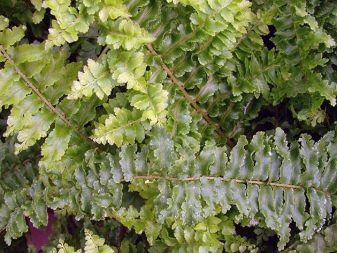
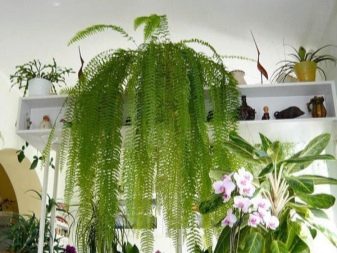
Exalted
This type of nephrolepis, taking into account the habitat conditions, can be not only a rhizome plant, but also an epiphyte. Moreover, in both cases, its root system grows vertically.
In the root zone, a very lush rosette is formed, which consists of pinnately complex leaf plates sitting on short petioles. The length of frond (dissected fern leaves) can reach 70 cm.
It should be noted that the segments are lanceolate, articulated and have a serrate-crenate edge.

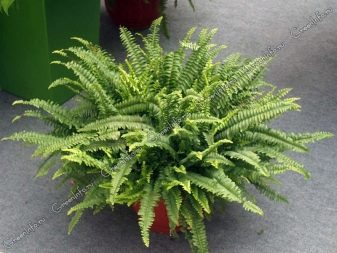
Hearty
The natural habitat of this species is more than wide and extends to the subtropics of two hemispheres. It has been cultivated since 1841, and its characteristic feature is swelling on the roots. It is worth noting that such thickening of the shoots in the ground are visually very similar to tubers. On their surface, you can distinguish small scales that have a white or silver color.
Another important feature is the branches oriented in height, that is, vertically. And also it is worth focusing on the dense segments of the stems with rounded contours, which are arranged according to a principle reminiscent of laying tiles on roofs.
Due to its decorative properties, the foliage of this fern species is often used by florists when decorating bouquet arrangements.

Xiphoid
Another common variety of the described representative of the huge family of ferns differs from its counterparts in the length of the segments of the leaf plates. Since the height in situations with such indoor flowers does not matter much, it is worth noting that with proper care and favorable conditions, their length can reach 20 cm. It turns out that the main distinguishing feature of xiphoid nephrolepis is the record size of the bush.
Considering this feature of the life form, it is more rational to place it in rooms corresponding in size.
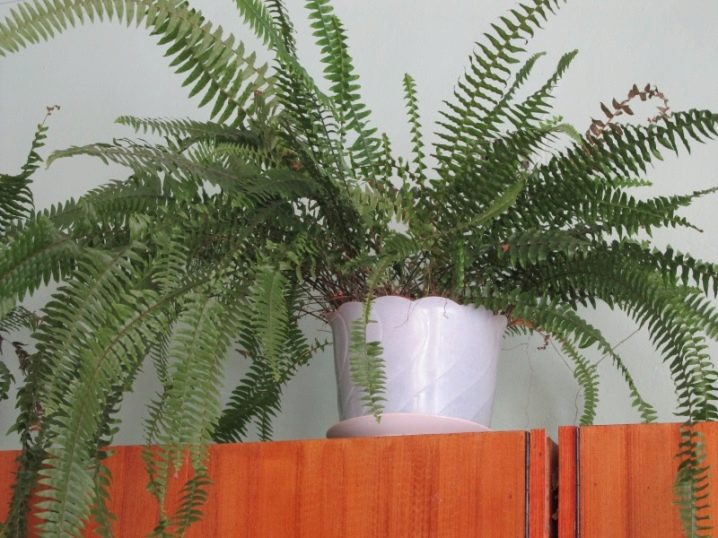
Other
In addition to the listed species, it is also worth paying attention to sickle nephrolepis. This is a fairly large representative of the fern family with fronds, capable of stretching up to 1 meter or more. They themselves have a yellowish-green color and jagged edges of the segments, the length of which is about 10 cm.

Today there are a large number of varieties of the above-mentioned sublime species. So, for growing in the garden and in indoor conditions, the popular varieties of nephrolepis were bred.
- Roosevelt's nephrolepis - a rather large fern, which is distinguished from others by the fronds sticking out in all directions, having wavy segments.
- Nephrolepis of Maas - a variety, the main feature of which is compactness, as well as corrugated sheet plates.
- Scott's nephrolepis - another small fern. It can be easily distinguished from its fellows by the curled edges of the leaf segments.
- Green Lady - a plant that, against the background of many analogues, stands out for its decorative appearance. The main advantage of the fern is a real fountain formed by openwork wavy leaves with pointed tops. They crown a vertically growing rhizome.
- Nephrolepis Emina - another undersized varietal variety. In this case, the characteristic feature is the presence of almost erect shoots with curly leaves, decorated with denticles along the edges.
- Boston, also called Nephrolepis Boston Is an upright fern originally developed in the United States. By the way, this variety was immediately able to gain record popularity among flower growers and breeders. It became the basis for the introduction of varieties with viyas, which have different featheriness and grow in length up to 1.2 meters. Segments are of two types: twisted or wavy.
- Hills and Fluffy Roughs - types of ferns, distinguished by double-feathery leaves.


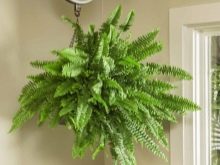
Among other things, such varieties as Whitman and Smith's nephrolepis are worthy of attention. The first is a plant with triple-feather foliage. In the second case, we are talking about a fern decorated with four-pinnate leaves.
Care
In general, this predominantly indoor flower can be confidently called unpretentious. But at the same time, you need to know how to properly care for it, including preventing diseases and pest attacks. It is important to take into account that hybrid varieties can have their own important characteristics that relate to the conditions of maintenance and rules of care. That is why novice growers, after buying a fern in a store, are strongly advised to carefully study the instructions, if any.

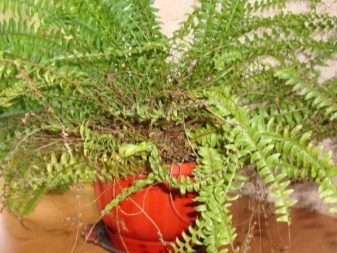
Climatic conditions
One of the key points is the lighting of the site chosen for nephrolepis. It is important to consider that this species, like all other ferns, does not tolerate direct sunlight well. For a plant, it is more preferable to flicker, diffused light, which in its natural habitat penetrates through the crowns of trees. Based on this, it is better not to place it on window sills and balconies. The north and north-east sides are the exception.
Among other things, the length of daylight matters. Taking into account the characteristics of the representative of the tropical flora under consideration, it should be from 14 to 16 hours. Naturally, in order to grow a lush and beautiful fern, you will need to use additional artificial lighting if necessary.
It is important to note that nephrolepis feels good and grows actively under lamps, on the basis of which it can be successfully diluted even in the complete absence of sunlight.
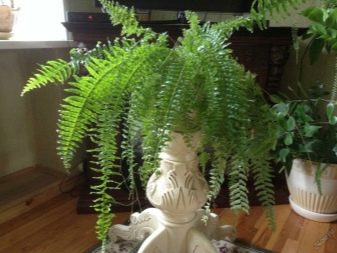
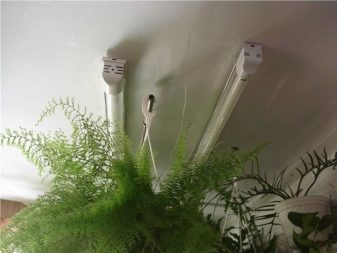
The next important factor is the temperature regime. In warm weather, the fern will feel comfortable if the thermometer is in the range from +20 to +24 degrees. With an increase in indicators, it is necessary to compensate for the heat by increasing air humidity. An effective tool in such situations will be regular spraying of the plant from a spray bottle. With the onset of autumn, the temperature is gradually lowered in places where nephrolepis is grown. In winter, the optimal indicator will be +15 degrees.
Like all ferns, nephrolepis prefers high humidity. Under optimal conditions for full-fledged growth and development of culture, it should be at least 60%. In winter, when heating systems are involved, it is recommended to place the plant away from heating appliances. It should be remembered that excessively dry air is likely to dry out the tips of the sheet plates. Experienced florists advise using modern moisturizers whenever possible.
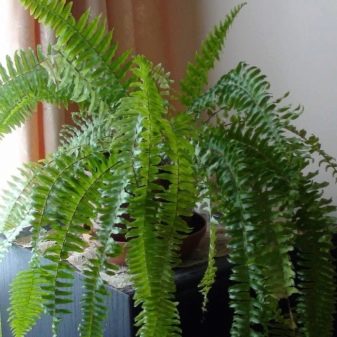

In the context of humidity, nephrolepis can be provided with comfortable conditions in the following ways.
- Regular spraying of the fern.
- Placing a pot with a plant on pallets with wet expanded clay or pebbles. It is important here that the bottom of the container does not come into contact with water.
- On hot days and during the heating season, you can use a warm shower. This will allow you to moisturize and at the same time clean the flower from dust and insects. It is recommended to cover the soil during such procedures with a film.
When evaluating the features of caring for the described plants and creating optimal conditions for them, one should take into account their ability to absorb harmful substances, as well as electromagnetic radiation. It is recommended to place ferns as close to working computers and other sources of electrical fields as possible. Nephrolepis effectively purifies the air in rooms where large groups of people are regularly found.
But it is important to remember that, despite all the unique abilities of the flower, it is very susceptible to tobacco smoke. Fern under its influence loses its useful qualities.
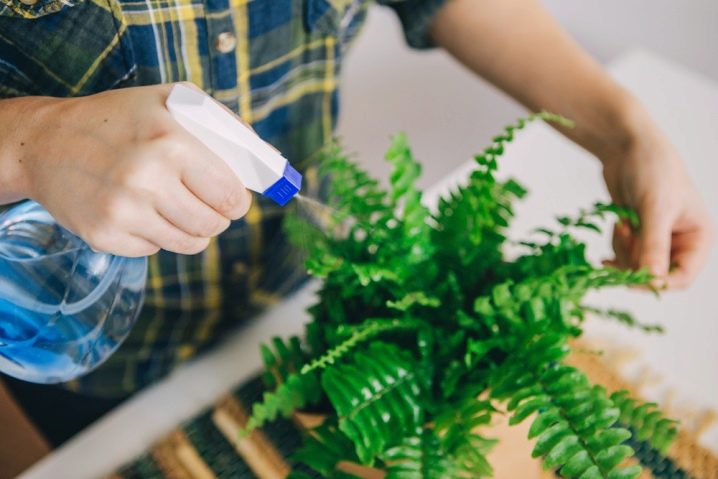
Top dressing
Nephrolepis should be fertilized regularly, but fertilization should be applied in moderation. The ideal fertilizer, of course, will be a complex specially designed specifically for ferns. However, it will also be possible to feed with a composition focused on decorative deciduous crops.
It is important to consider that when choosing an alternative option, the dosage will need to be reduced by a quarter.
Top dressing is applied in the period from March to September with an interval of 2-3 weeks. Carry out the appropriate procedures in parallel with watering. With the so-called cold wintering, fertilizers are generally not needed for the plant, and all such activities are interrupted before the onset of spring. If the temperature is higher than the recommended one, then you should continue to fertilize the soil, doubling the intervals between fertilizing and reducing the concentration.

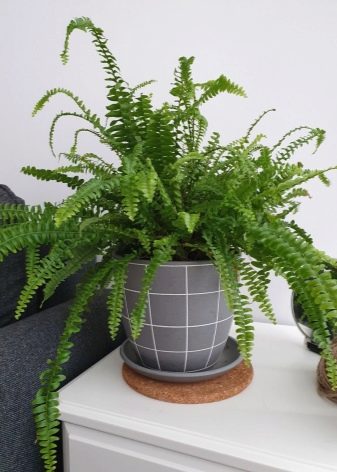
Watering
It is recommended to water the described plants in compliance with the principle of the golden mean. It is highly undesirable to allow waterlogging of the soil, as well as its drying out. In spring, summer and early autumn, watering is carried out 2-3 times a week as the top layer of the soil dries up. In winter, the frequency of procedures is increased to 1 time per week, while reducing the amount of water.
It is strongly recommended to use clean (filtered, settled or boiled) and melt water. And also do not forget about the need to periodically (1-2 times a day) spray the fern. Bottom watering is ideal, where the pot is placed in a pan of water.
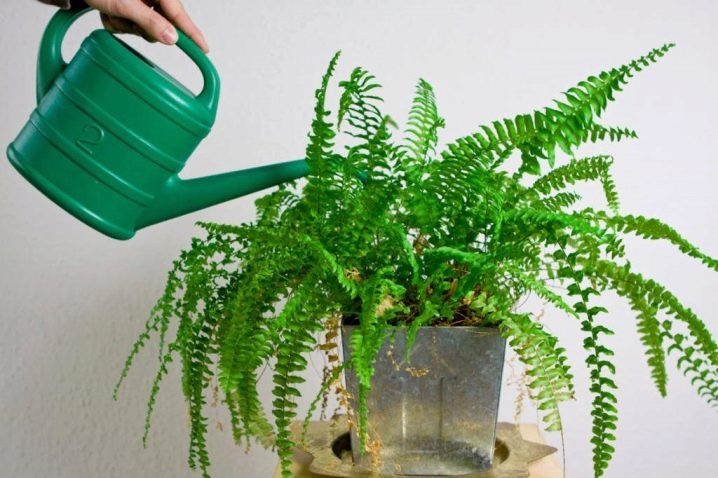
Transfer
As the root system of nephrolepis grows, it will need to be transplanted. Up to 3 years of age, a similar procedure is performed annually, and later - as necessary and taking into account the growth and development of the fern. As a rule, plants are transplanted into large containers in spring. And the algorithm of actions itself includes the following steps.
- A new, more spacious pot is selected, which should be wide enough and at the same time not very deep.
- At the bottom of the container, a drainage layer of pebbles or expanded clay is formed, which prevents moisture stagnation and, at the same time, provides air access to the roots.
- The plant must be removed from the old pot together with an earthen lump.
- Nephrolepis is placed in a new place, after having poured a thin layer of soil mixture over the drainage. In this case, you can use both a ready-made purchase and a home-made option. In the second case, the substrate is made by mixing greenhouse and coniferous soil in equal proportions, as well as peat, adding bone meal or ash.
- The roots, carefully, so as not to damage, are sprinkled on the sides, leaving the root collar on the surface.
- The transplanted nephrolepis is watered.
The first two weeks after transplanting, it is necessary to constantly monitor that the soil remains sufficiently moist, and the lower leaves of the fern do not dry out.
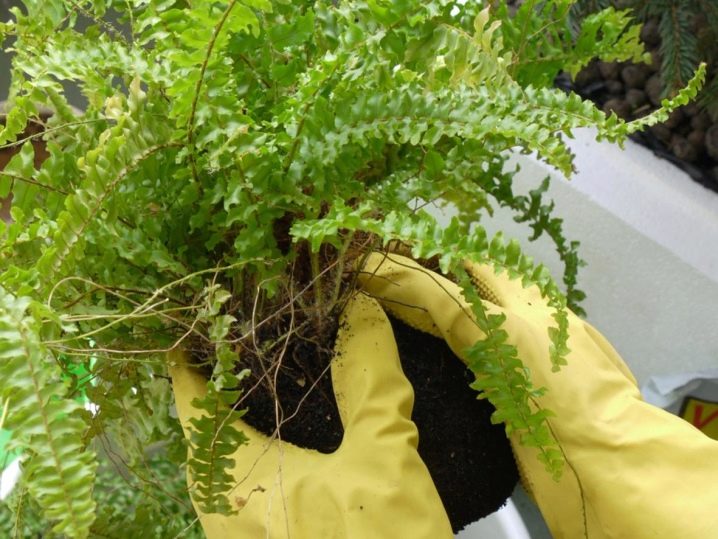
Diseases and pests
In the overwhelming majority of cases, the source of problems in the cultivation of nephrolepis is the violation of the key rules of plant care. At the same time, symptoms of various diseases appear. So, if the tips of the leaves dry up and change their color to brown, then we are most often talking about insufficient air humidity. At the same time, twisting of the plates indicates a lack of moisture or, conversely, excessive watering. Also, the list of reasons may include the use of hard water for irrigation and regular exposure to drafts.
Often, right after the purchase, the owners are faced with such a nuisance as falling foliage. In situations like this, it is usually a change in conditions that is the cause. The plant will just take time to adapt.
One of the most serious troubles associated with growing nephrolepis is root rot. This is caused by factors such as stagnant moisture and temperature fluctuations. As practice shows, if appropriate measures are not taken in a timely manner, the plant may well die. Measures aimed at eliminating the consequences of diseases include the removal of the affected areas and treatment with appropriate drugs.
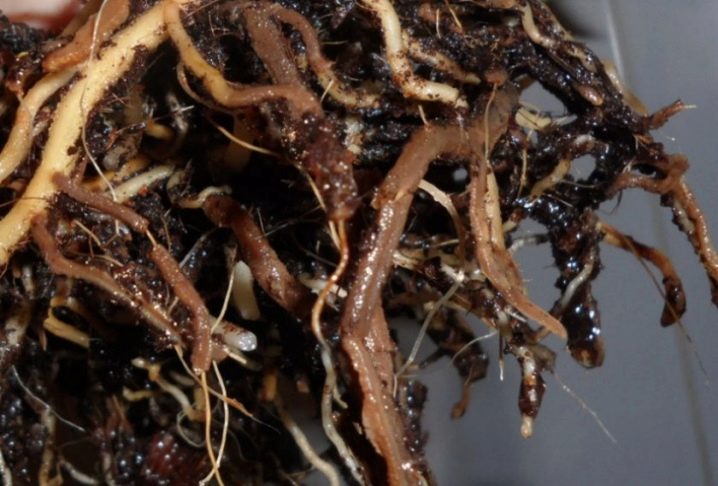
In addition to diseases that are the consequences of violation of the rules of care and leading to a deterioration in the decorative qualities of the fern, attention should be paid to possible attacks of harmful insects. Most often, nephrolepis is annoyed by:
- mealy worm;
- spider mite;
- aphid;
- shield.
The presence of a spider mite can be identified by small white dots on the foliage and a change in its color. Plants kept in excessively dry conditions are most often attacked. Moisturizing the soil, spraying regularly, and a warm shower will help get rid of the pest.
For other unwanted insects, insecticides will be the most effective control agents.


Reproduction
At home, indoor varieties of nephrolepis can be propagated in several ways. And in this case we are talking about disputes, tubers, shoots and division of the rhizome. The first option is very interesting, but far from the easiest and fastest.
It is also important to consider that when grown indoors, the fern very rarely produces spores that are suitable for reproduction.
This method will be relevant primarily for those who like to experiment. Spores - small brown formations on the underside of the leaves - are gently scraped off. The further procedure is as follows:
- the soil is abundantly moistened, and seeds are distributed over its surface;
- the container is covered with film or glass, transferred to a dark and at the same time warm place;
- the mini-greenhouse is ventilated every day, and the soil in it is irrigated;
- after the emergence of shoots (from 1 to 3 months), the shelter is removed, and the container is brought out into the light;
- growing seedlings are thinned out, leaving at least 3 cm intervals between the strongest;
- a month later, the young are seated in 2-3 copies in one container.
Nephrolepis often produces aerial shoots with no leaves. Such whips are notable for the fact that they take root easily. They will need to be pressed to the ground and fixed with pins or ordinary wire and lightly sprinkled. After 10-14 days, the shoots will take root, and foliage will begin to form on them. After the young plant is strong enough, it is separated from the mother and planted.
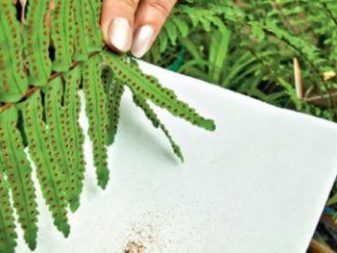
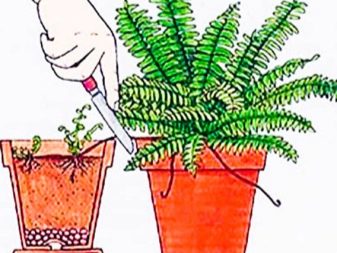
One of the unusual ways is tuber propagation. As already noted, peculiar thickenings are formed on the roots of individual varieties of the described fern. They will need to be carefully separated during the next plant transplant and planted in the ground. As practice shows, one new nephrolepis grows from one such tuber.
The most popular, simple and reliable method of fern propagation today is rhizome division or bush division. The most favorable period will be the beginning of spring. The healthiest and strongest specimens are divided when transplanted. After that, each part that has a growth point is planted in a separate pot, and removed to a warm and well-lit place, covered in front of this bag. After the plants are strong, the shelter can be removed.
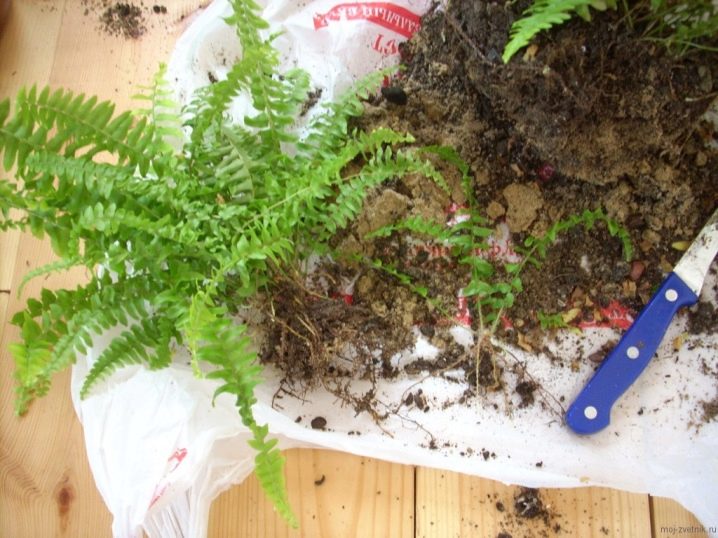































The comment was sent successfully.